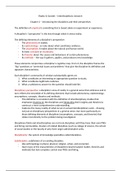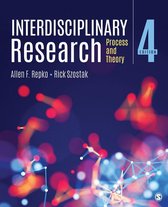Repko & Szostak – interdisciplinary research
Chapter 2 – introducing the disciplines and their perspectives
The definition of empirical is something that is based solely on experiment or experience.
A discipline’s “perspective” is the lens through which it views reality.
The defining elements of a discipline’s perspective:
- The phenomena it studies.
- Its epistemology - or rules about what constitutes evidence.
- The assumptions it makes about the natural and human world.
- Its basic concepts or vocabulary.
- Its theories about the causes and behaviours of certain phenomena.
- Its methods – the way it gathers, applies, and produces new knowledge.
These elements compromise a discipline’s cognitive map. From it, the discipline frames the
“big” questions or “perennial issues and problems” that give the discipline its definition and
signature characteristics.
Each discipline’s community of scholars substantially agrees on:
1. What constitutes an interesting an appropriate question to study;
2. What constitutes legitimate evidence;
3. What a satisfactory answer to the question should look like.
Disciplinary perspective: a discipline’s view of reality in a general sense that embraces and in
turn reflects the ensemble of its defining elements that include phenomena, epistemology,
assumptions, concepts, theories and methods.
- This definition is consistent with the definition of interdisciplinary studies that
emphasize drawing on the disciplines and integrating their insights and theories to
construct a more comprehensive understanding.
- Captures the messy reality of what occurs in actual interdisciplinary work – drawing
not just on disciplinary perspectives in a general sense, but more particularly on
those defining elements of disciplines (assumptions, concepts, and theories) that
relate most directly to the problem being investigated.
Disciplinary fields and interdisciplines are not truly disciplines until they have their own PhDs
and hiring communities. Clusters of related disciplines (such as college of science, the school
of social studies or the faculty of arts) form larger administrative units.
Disciplinarity: the system of knowledge specialties called disciplines.
Subdiscipline: subdivision of an existing discipline.
- Like anthropology (cultural, physical, religion, urban, and economic).
- Have many of the characteristics of disciplines (shared subject matter, theories and
methods) but lack complete control over PhDs and hiring.
, - Can have different sets of questions, theories, and methods from the broader
discipline.
Interdiscipline: the space between the intellectual content of two or more disciplines.
- May begin as an interdisciplinary field, but over time, it may become like a discipline
(developing its own curriculum, journals, professional associations, and (most
important for interdisciplinary studies) perspective.
- Biochemistry and neuroscience became their own mainstream disciplines.
Today’s disciplines exhibit characteristics about which you should be mindful as you study
their defining elements:
1. Disciplines are constantly evolving and taking on new elements – study new
phenomena or applying new theories or methods.
a. This means there is some diversity within the discipline at any point in time,
but the institutional structure of disciplines ensures that there is still
coherence.
2. Some disciplines are characterized by cognitive discord – disagreement among a
discipline’s practitioners over the defining elements of the discipline.
a. This raises the question whether some disciplines even have a general
perspective on reality. The answer Is yes, because the idea of a discipline as
something entirely coherent (in terms of strict adherence to its defining
elements – assumptions, concepts, theories and methods) is an idealization.
b. The reality of disciplinarity, past and present, is ferment and fragmentation.
a. Counterbalancing these centripetal forces to a large degree is an
intellectual centre of gravity that enables each discipline to maintain
its identity and have a distinctive overall perspective. As long as
disciplines bestow PhDs and make hiring decisions, there will be a
strong pressure to decide what a suitable sociologist or art historian is.
3. The growing practice of crossing disciplinary boundaries by disciplinarians
themselves. Disciplines borrowing concepts, theories, and methods from one
another.
a. The movement of methods and analytical approaches across
disciplinary boundaries has become an important feature of
knowledge production today.
b. Textuality, narrative and interpretation no longer only belong to the
domain of literary studies.
c. Interdisciplinary scholarship encourages such borrowing and thus
enhances the ability of disciplines to answer disciplinary research
questions.
Interdisciplinarians should approach disciplines not as self-contained repositories of
information, but as being open to a wider range of concepts, theories and methods that
transcend their traditional boundaries.
- Researchers should not only examine the characteristic elements of relevant
disciplines for insights into the problem, but also search for information from sources
that transcend disciplines such as the categories of phenomena, and the schools of
thought.
, A discipline may be considered part of one category at one university but belong to a
different category at another.
- Like history, which is considered a social science in some institutions, but part of
humanities at others.
Disciplinary perspectives are used in two circumstances:
1. Near the beginning of the research process where the focus is on identifying the
disciplines that are potentially interested in the problem.
a. Once a disciplines overall perspective on reality is known, it is relatively easy
to apply the perspective to the problem.
b. Identifying potentially interested disciplines early on helps to narrow the
disciplinary literatures that need to be consulted when performing the full-
scale literature search.
2. Developing adequacy in relevant disciplines and analysing the problem.
a. A disciplines perspective is not identical with the insights the discipline
produces. A disciplines expert produces insights and theories concerning a
problem or class of problems.
b. Interdisciplinarians draw on these insights and theories, analyse them,
identify how they conflict, modify them by creating common ground among
them, integrate them, and construct a more comprehensive understanding of
the problem.
Phenomena: enduring aspects of human existence that are of interest to scholars and are
susceptible to scholarly description and explanation.
- Example: individuals may differ in terms of personality, but a set of personality
characteristics is always with us.
Disciplines are ever changing, and their borders are elastic and porous. This reality and the
absence of a logical classification of phenomena to guide the disciplines have produced two
unfortunate events:
1. Several disciplines may share a phenomenon, often unmindful of the efforts of other
disciplines to comprehend it.
a. Psychology and religious studies share an interest in the phenomenon of
terrorism – but rarely finds in their work references to the theories and
research of the other discipline.
2. Disciplines may ignore a particular phenomenon altogether.
a. The causes of economic growth (which has been a focus of economist) had
not been studied by history or political science.
Interdisciplinary scholars, like their disciplinary counterparts, must identify the phenomena
relevant to the research question.
1. Approach the disciplines serially in hopes of locating a particular phenomenon in one
or more of them.
2. Focus on the phenomenon itself.






